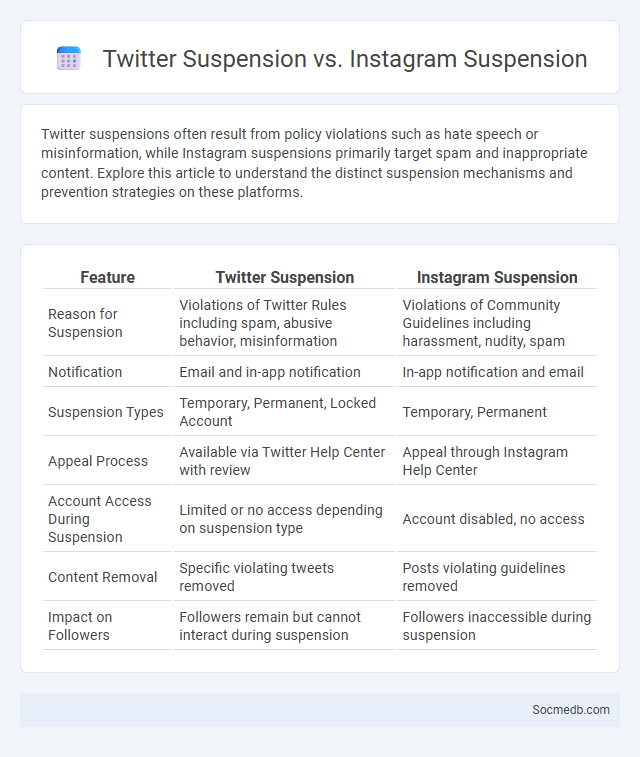
Photo illustration: Twitter Suspension vs Instagram Suspension
Twitter suspensions often result from policy violations such as hate speech or misinformation, while Instagram suspensions primarily target spam and inappropriate content. Explore this article to understand the distinct suspension mechanisms and prevention strategies on these platforms.
Table of Comparison
| Feature | Twitter Suspension | Instagram Suspension |
|---|---|---|
| Reason for Suspension | Violations of Twitter Rules including spam, abusive behavior, misinformation | Violations of Community Guidelines including harassment, nudity, spam |
| Notification | Email and in-app notification | In-app notification and email |
| Suspension Types | Temporary, Permanent, Locked Account | Temporary, Permanent |
| Appeal Process | Available via Twitter Help Center with review | Appeal through Instagram Help Center |
| Account Access During Suspension | Limited or no access depending on suspension type | Account disabled, no access |
| Content Removal | Specific violating tweets removed | Posts violating guidelines removed |
| Impact on Followers | Followers remain but cannot interact during suspension | Followers inaccessible during suspension |
Understanding Social Media Suspensions
Social media suspensions occur when platforms temporarily or permanently restrict user accounts due to violations of community guidelines or terms of service, such as hate speech, harassment, or misinformation. Understanding the specific policies of platforms like Facebook, Twitter, and Instagram can help users avoid actions that trigger suspensions. Users can typically appeal suspensions through platform-specific processes to restore account access or clarify misunderstandings.
Key Reasons for Twitter Suspensions
Twitter suspensions often stem from violations of platform policies, including spreading misinformation, engaging in hate speech, or promoting violence. Automated systems and user reports contribute to identifying accounts involved in spam, harassment, or abusive behavior. Persistent breaches of Twitter's rules result in temporary or permanent suspensions to maintain community safety and platform integrity.
Common Causes of Instagram Suspensions
Instagram suspensions often result from violations such as posting inappropriate content, engaging in spammy behavior, or using unauthorized third-party apps. Accounts may also be suspended due to repeated breaches of Instagram's Community Guidelines, including hate speech, harassment, or misinformation. Understanding and adhering to Instagram's policies reduces the risk of account suspension and promotes a safer social media experience.
General Suspension Policies Across Platforms
Major social media platforms enforce general suspension policies that target violations such as hate speech, harassment, misinformation, and spam. These policies empower companies like Facebook, Twitter, and Instagram to deactivate accounts temporarily or permanently based on severity and frequency of offenses. Consistent enforcement helps maintain community standards and user safety across diverse digital environments.
Appeal Processes: Twitter vs Instagram
Twitter's appeal process allows users to contest account suspensions or content removals through a structured form, often involving a review by the Trust and Safety team with response times varying from a few hours to several days. Instagram utilizes a similar appeal mechanism where users can request a re-evaluation of flagged content or account restrictions via the app's Help Center, typically involving automated checks followed by manual review when necessary. Both platforms emphasize transparency in enforcement but differ in response speed and user interface simplicity, impacting user experience during appeals.
Impact of Suspension on User Accounts
Social media account suspension disrupts users' ability to engage with their online communities, leading to lost connections and diminished reach for personal branding or business purposes. Suspended accounts often experience decreased visibility and trust, affecting followers' perception and content engagement. Recovery processes can be lengthy and complex, causing further frustrations and potential permanent loss of digital presence.
Policy Differences: Twitter vs Instagram
Twitter's social media policy emphasizes real-time public conversation with strict rules against misinformation, hate speech, and harassment, often implementing fact-check labels and temporary account restrictions. Instagram prioritizes a visually-driven community, focusing heavily on user safety through AI-driven content moderation, combatting bullying, and protecting mental health by hiding likes and filtering harmful comments. The contrasting policies reflect Twitter's commitment to open dialogue and Instagram's emphasis on positive, visual content experiences.
Reactivation and Recovery Steps
Social media reactivation involves restoring access to previously disabled or deactivated accounts by following platform-specific recovery protocols, which often include identity verification and password reset procedures. Recovery steps typically require users to verify their identity through email or phone authentication, answer security questions, or submit government-issued ID for account validation. Ensuring compliance with social media platforms' terms of service and promptly addressing security alerts enhances the likelihood of successful reactivation and account recovery.
Preventing Account Suspensions
Preventing account suspensions on social media requires consistent adherence to platform-specific community guidelines and terms of service. Regularly reviewing content policies and avoiding activities such as spamming, posting prohibited material, or engaging in harassment significantly reduces the risk of suspension. Implementing two-factor authentication and monitoring account activity for unauthorized access also enhances account security and helps maintain compliance.
Best Practices for Social Media Compliance
Adhering to social media compliance involves understanding platform-specific rules, maintaining data privacy, and ensuring transparent communication. Companies should implement regular training on legal guidelines, monitor content for regulatory adherence, and document approval processes to mitigate risks. Utilizing compliance management tools enhances consistency and accountability in social media strategies.
 socmedb.com
socmedb.com